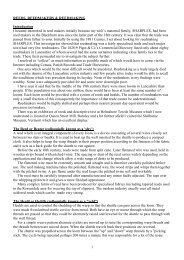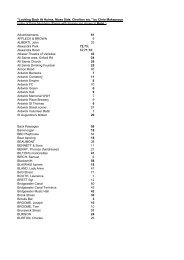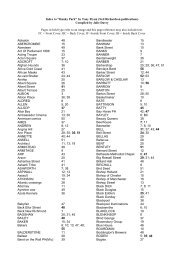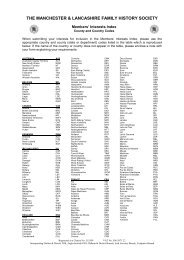The Roles of William and John Henry Royle in the Development of ...
The Roles of William and John Henry Royle in the Development of ...
The Roles of William and John Henry Royle in the Development of ...
You also want an ePaper? Increase the reach of your titles
YUMPU automatically turns print PDFs into web optimized ePapers that Google loves.
<strong>Royle</strong>(s). <strong>The</strong>ir rental payments contributed greatly to <strong>the</strong> function<strong>in</strong>g <strong>of</strong> <strong>the</strong> local<br />
economy, especially with <strong>the</strong> slow <strong>and</strong> steady decl<strong>in</strong>e <strong>of</strong> <strong>the</strong> h<strong>and</strong>loom weav<strong>in</strong>g<br />
<strong>in</strong>dustry due to <strong>the</strong> Napoleonic Wars. This factor <strong>and</strong> <strong>the</strong> onset <strong>of</strong> <strong>the</strong> effects <strong>of</strong><br />
enclosure, which denied many access to <strong>the</strong> l<strong>and</strong> on a large scale, meant that <strong>the</strong>re was<br />
now an economic ‘gap,’ which rapid <strong>in</strong>dustrialisation filled <strong>in</strong> <strong>the</strong> latter part <strong>of</strong> <strong>the</strong> 19 th<br />
century. Flixton Mill came to <strong>the</strong> area <strong>in</strong> 1851, provid<strong>in</strong>g a new outlet for <strong>the</strong> now<br />
outmoded h<strong>and</strong>loom weavers <strong>and</strong> those whose access to smallhold<strong>in</strong>g l<strong>and</strong> was now<br />
much restricted. L<strong>and</strong> own<strong>in</strong>g, occupation <strong>and</strong> conveyance, toge<strong>the</strong>r with <strong>the</strong> properties<br />
that occupied <strong>the</strong>m, were conf<strong>in</strong>ed to those who had <strong>the</strong> f<strong>in</strong>ancial means to afford this<br />
undertak<strong>in</strong>g. Essentially, this was <strong>the</strong> larger l<strong>and</strong>owners, or those whose families had<br />
traditionally farmed larger properties for centuries - <strong>the</strong> Wright family <strong>of</strong> Flixton<br />
House, for example. O<strong>the</strong>rs <strong>in</strong>volved were ak<strong>in</strong> to <strong>the</strong> <strong>Royle</strong>s, who had established<br />
<strong>the</strong>mselves successfully <strong>in</strong> bus<strong>in</strong>ess <strong>and</strong> could use <strong>the</strong>ir new found affluence to acquire<br />
property <strong>in</strong>terests, such as Pool Plat. <strong>The</strong> <strong>in</strong>creas<strong>in</strong>g rate <strong>of</strong> urbanisation <strong>and</strong> <strong>the</strong><br />
establishment <strong>of</strong> relatively large - scale <strong>in</strong>dustries <strong>in</strong> villages like Flixton, with little<br />
previous history <strong>of</strong> <strong>in</strong>dustrial development, meant that <strong>the</strong> population <strong>in</strong>creased<br />
significantly. This was to <strong>the</strong> benefit <strong>of</strong> trades people like <strong>the</strong> <strong>Royle</strong>s, whose bus<strong>in</strong>esses<br />
thrived through <strong>the</strong> <strong>in</strong>creased dem<strong>and</strong> that urbanisation brought with it. However,<br />
despite <strong>the</strong> rapid economic changes <strong>of</strong> <strong>the</strong> 19 th century <strong>the</strong> close bus<strong>in</strong>ess, l<strong>and</strong> deal<strong>in</strong>g<br />
<strong>and</strong> family l<strong>in</strong>ks <strong>of</strong> <strong>the</strong> <strong>Royle</strong>s cont<strong>in</strong>ue <strong>in</strong> Flixton with fur<strong>the</strong>r <strong>in</strong>terest shown <strong>in</strong> Pool<br />
Plat <strong>in</strong>to <strong>the</strong> latter years <strong>of</strong> <strong>the</strong> 19 th century <strong>and</strong> <strong>the</strong> first decade <strong>of</strong> <strong>the</strong> 20 th century.<br />
<strong>The</strong> l<strong>and</strong>ed, property <strong>and</strong> bus<strong>in</strong>ess <strong>in</strong>terests <strong>of</strong> <strong>William</strong> Harper <strong>in</strong> <strong>the</strong> Green Lane<br />
area <strong>of</strong> Flixton <strong>and</strong> his connection to George <strong>Royle</strong>’s occupation <strong>of</strong> property <strong>in</strong> <strong>the</strong><br />
vic<strong>in</strong>ity, gives us an <strong>in</strong>sight <strong>in</strong>to <strong>the</strong> development <strong>of</strong> <strong>the</strong>se families <strong>in</strong>fluence <strong>in</strong> <strong>the</strong><br />
area. <strong>The</strong> fact that <strong>Royle</strong>s occupied Harper property <strong>and</strong> were <strong>the</strong>re at <strong>the</strong> time <strong>of</strong><br />
<strong>William</strong> Harper’s death meant that <strong>the</strong>y were able to benefit from <strong>the</strong> property<br />
connection, occupy<strong>in</strong>g Rocksavage from approximately <strong>the</strong> 1850s, until 1937. In regard<br />
to George <strong>Royle</strong>, <strong>the</strong>re are several with this name <strong>in</strong> Flixton, all engag<strong>in</strong>g <strong>in</strong> trades<br />
which could be connected to <strong>William</strong> <strong>and</strong> <strong>John</strong> <strong>Henry</strong>’s occupations <strong>of</strong> grocer <strong>and</strong><br />
baker. <strong>The</strong>re would appear to be a very well established network <strong>of</strong> extended family<br />
bus<strong>in</strong>ess concerns, stretch<strong>in</strong>g <strong>in</strong>to <strong>the</strong> <strong>in</strong>fluence <strong>of</strong> o<strong>the</strong>r bus<strong>in</strong>ess <strong>and</strong> trade connected<br />
Flixton families, <strong>of</strong> equal st<strong>and</strong><strong>in</strong>g. Many owned l<strong>and</strong>, as well as property <strong>and</strong> a<br />
bus<strong>in</strong>ess, show<strong>in</strong>g <strong>the</strong> duel skills required to ma<strong>in</strong>ta<strong>in</strong> a successful reputation <strong>in</strong> <strong>the</strong><br />
community. <strong>The</strong>se smallholders were an important part <strong>of</strong> <strong>the</strong> village economy, both<br />
liv<strong>in</strong>g <strong>in</strong> close proximity <strong>and</strong> trad<strong>in</strong>g with one ano<strong>the</strong>r; <strong>the</strong>y were also an important<br />
element <strong>in</strong> <strong>the</strong> social fabric <strong>of</strong> villages like Flixton. <strong>The</strong> question <strong>of</strong> how this relates to<br />
<strong>the</strong> ownership <strong>and</strong> development <strong>of</strong> smallhold<strong>in</strong>gs like Pool Plat rema<strong>in</strong>s. As<br />
mentioned, <strong>the</strong>re was an element <strong>of</strong> reta<strong>in</strong><strong>in</strong>g a successful reputation, important to any<br />
bus<strong>in</strong>ess. Also, <strong>in</strong> terms <strong>of</strong> raw materials, rental returns <strong>and</strong> pr<strong>of</strong>its from conveyance, it<br />
was necessary to <strong>in</strong>tegrate several entrepreneurial skills to be an efficient bus<strong>in</strong>essman<br />
<strong>and</strong> <strong>the</strong> deal<strong>in</strong>gs around <strong>the</strong> ownership <strong>and</strong> build<strong>in</strong>g developments on Pool Plat would<br />
satisfy this necessity. <strong>The</strong> ownership <strong>of</strong> several properties <strong>in</strong> Flixton <strong>and</strong> beyond, to<br />
<strong>in</strong>clude numbers 1 - 8 V<strong>in</strong>e Cottages, Bowdon (E/18/60) would po<strong>in</strong>t to rental pr<strong>of</strong>its<br />
41













